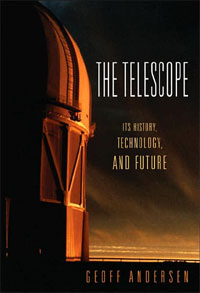|
|
Review: The Telescope
by Jeff Foust
Monday, July 16, 2007
The Telescope: Its History, Technology, and Future
by Geoff Andersen
Princeton Univ. Press, 2007
hardcover, 256 pp., illus.
ISBN 0-691-12979-7
US$29.95
Last Friday night marked the “first light” for the newest major astronomical telescope in the world, the Gran Telescopio Canarias (GTC) in the Canary Islands. When complete—only 12 of its 36 mirror segments were in place as of first light—the GTC will have a primary mirror with a diameter of 10.4 meters, eclipsing the twin Keck Observatory telescopes in Hawaii as the world’s largest. (The Hobby-Eberly Telescope in Texas and the South African Large Telescope each have elliptical mirrors 11 meters across on their long axes, but have an effective diameter of “only” 9.2 meters because of the way they operate.) The GTC’s claim as the world’s largest optical telescope is likely to be brief, though, as even larger telescopes are in various stages of design and development. It’s the latest stage in an astronomical arms race that, over the last two decades, has seen a proliferation of telescopes of diameters of six to ten meters. Why and how these telescopes have been developed is a central topic in Geoff Andersen’s book, The Telescope.
The Telescope starts as an early history of the development of the telescope, including the pre-history of naked-eye astronomical observations through the early developments by inventors both famous (Galileo) and obscure (Hans Lippershey, a Dutchman who actually invented the refractor telescope that would later be refined, improved upon, and utilized by Galileo.) Andersen, a research physicist at the US Air Force Academy, diverges from a strictly chronological approach to the subject, going into detail about optics, telescope design, cameras and other instruments used with telescopes, and the siting and design of observatories. He even digresses from a strict discussion of astronomy to examine the other uses of telescopes, from laser communications to remote sensing by both aircraft and satellites. While there are plenty of ray diagrams and interferometic patterns included to illustrate basic optics of telescopes, Andersen avoids becoming too technical: at one point, after displaying the relatively simple equation for diffraction-limited angular resolution, he adds, “I had to promise to the publishers that there would be only one formula in this book, so you can probably understand that it must be an important one.” (There are, actually, additional formulas in the book, but they are limited to the appendices.)
| We’re living in what could well be considered a golden age for astronomy, as both space and terrestrial technology allows us to look further, deeper, and more sharply into the universe than ever before, in search of both our origins and our ultimate fate. |
While the book is intended to be broad-ranging and not too technical, there are limits to the scope of the topics included. Andersen focuses on telescopes that work in the visible and infrared portions of the spectrum. As such, there’s virtually no discussion of the very different designs and requirements of radio telescopes or space-based x-ray and gamma-ray telescopes like Chandra and Integral. (Andersen does discuss that most famous of space-based telescopes, Hubble, as well as its successor, the James Webb Space Telescope.) A chapter late in the book, “Key discoveries”, highlights a hodgepodge of astronomical discoveries that in the author’s opinion are less well known, such as the Hubble Ultra Deep Field and the discovery of a supermassive black hole at the center of the Milky Way. However, the chapter has the feel of a “grab bag” of random discoveries without a unifying theme, and Andersen’s comment that these are more obscure discoveries belies the title of the chapter. The book would have been stronger had this chapter been replaced with one that examined how telescopes that operate at other wavelengths work.
Overall, though, The Telescope provides the reader with an enlightening and engaging overview of how telescopes have developed over the last four centuries and how they are designed and used today. As telescopes continue to become bigger and more powerful—one proposed telescope mentioned at the end of the book, with a primary mirror up to 100 meters across, is simply known as OWL, for “Overwhelmingly Large Telescope”—it’s a reminder that we’re living in what could well be considered a golden age for astronomy, as both space and terrestrial technology allows us to look further, deeper, and more sharply into the universe than ever before, in search of both our origins and our ultimate fate.
Jeff Foust (jeff@thespacereview.com) is the editor and publisher of The Space Review. He also operates the Spacetoday.net web site and the Space Politics and Personal Spaceflight weblogs. Views and opinions expressed in this article are those of the author alone, and do not represent the official positions of any organization or company, including the Futron Corporation, the author’s employer.
|
|
